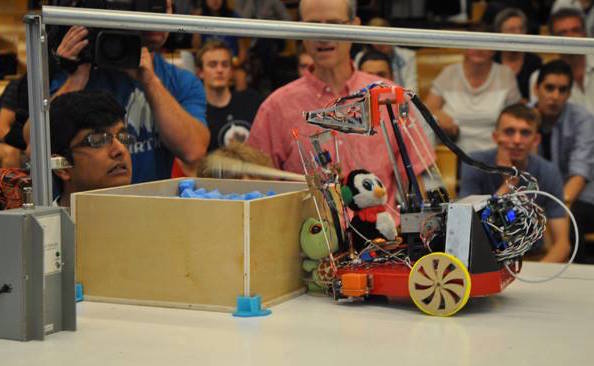
F.E.T.C.H is a fully autonomous robot built to compete in the 2015 Engineering Physics robot competition. Our team included Akshiv Bansal, Charles McGrath, Cyrus Neary, and Ian Thompson. At the time of the competition, all four of us were in our second year at UBC, studying Engineering Physics. We worked together to design, fabricate, and test F.E.T.C.H.
The Engineering Physics robot competition is an annual event in which second year engineering physics students have 5 weeks to design and build a fully autonomous robot designed to complete a given task. This is a part of the Engineering Physics 253 course, which provides students with an introduction to prototyping, mechanical and electrical design, and control software. The theme of the 2015 competition is pet rescue from a fire at the SPCA. In the “Fire at the SPCA” competition, teams build robots that autonomously navigate a 2 level stage (connected by a sloped section), rescue 6 stuffed animals from an imaginary fire, and safely return them to the starting area in under 2 minutes. From the start location, there is black tape that the robot is able to follow partway across the stage. Three pets are placed at various points along the path, 8 inches to the right of the tape. The 4th animal is at the end of the black tape, sitting on the path. Animal 5 is placed 6 inches above the ground, 8 inches to the right of an imaginary line that connects the end of the tape, and an IR beacon at the end of the competition stage. Animal 6 is buried in a bucket of foam that is also in line with the end of the tape, and the IR beacon. Adjacent to the bucket, there is a zip line that returns to the starting area. There is also a second IR beacon directly opposite the zip line, that allows robots to re-find the tape. However, there is a wall of fire, that emerges from the stage 60 seconds after the robot begins its run, effectively blocking the black tape path after this point in time. Teams competed to score the most points in the least amount of time. Pets 1-4 being worth 1 point, pet 5 worth 2 points, and pet 6 worth 3 points. The 2015 competition was one of the most hotly contested competitions in recent memory, and attracted attention from many spectators, and provincial and national media.